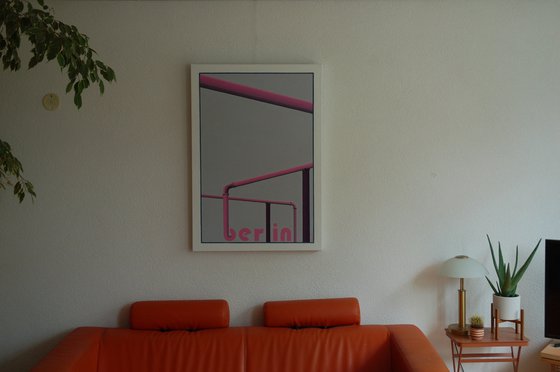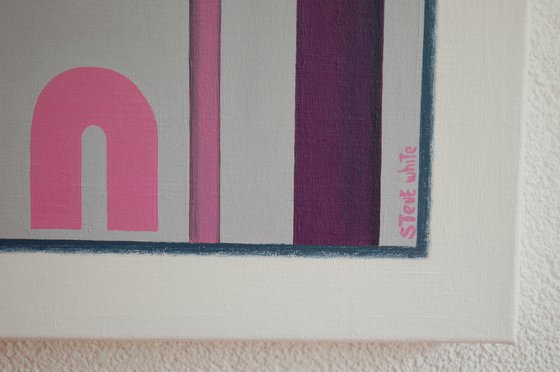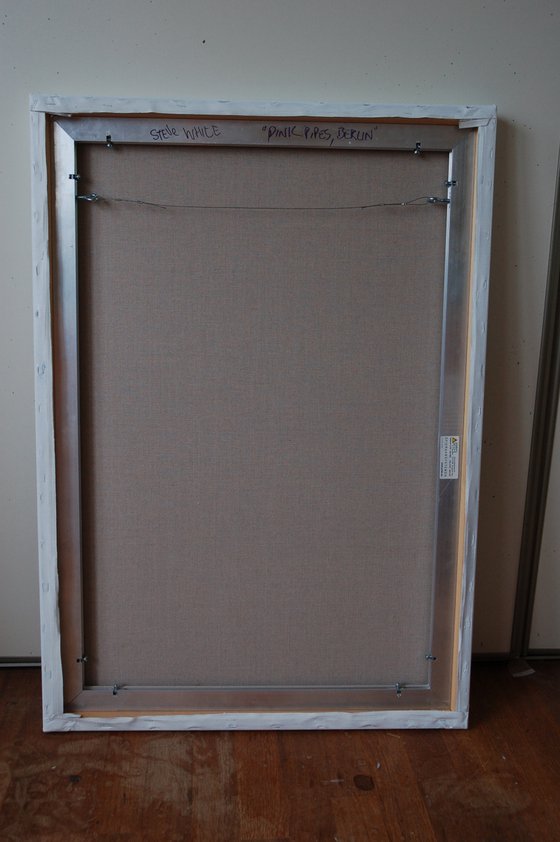- By medium
- By subject
- By budget
- Sales
- Gift cards
- Discover all art
- Artists
- Editors’ picks
- Ideas
Original artwork description:
Berlin's renowned avant garde art scene includes its overhead snarl of day-glo pink pipes, which resemble an oil refinery designed by Grayson Perry. When I think of Berlin I don't think of Hilter's bunker, the Brandenburg Gate, The Wall or a hulking dustbin-lid-sized helping of steaming currywurst. I think of pink pipes. These pipes festoon the city like gay conduits in Willy Wonka's chocolate factory. It's as if the famous Bulgarian envirnomental artist Christo, who, in 1995, after 24 years of lobbying, wrapped the Reichstag in 100,000 square metres of silver fabric, decided, for an encore, that he would drape the whole city in an overhead aqueduct of elephantine strips of coral-coloured licquorice. The pink pipes are mad, florid, fabulous, odd.
The reason for the pipes is prosaic and also patently obvious to those of us well versed in knowledge of the West Slavonic language: Berl-in means swamp-settlement. Berlin was/is built on a marsh. Before the construction of a new building can start the groundwater needs to be pumped away. The fuschia arteries carry malodorous water from new construction sites to canals or the River Spree. The company that has mostly supplied the pipes, Pollem, researched the best colour for the pipes and found that, unlike the rest of the world which tends to favour the colour blue (then red, green and purple) pink topped its colour poll. It was children's favourite colour (until they went to school and were programmed to think it was purely girly) and adults prefered pink because it reminded them of their youth, when life was....er, fun.
Berlin without its pink pipes would be like Milan without La Scala, Rio without Christ the Redeemer or that idiot place in Australia with the giant plastic pineapple. Berliners are rightly proud of their pink pipes, and when one asks you if you want to catch the tube he is not directing you to the U-Bahn, but he wants you to appreciate an unusually configured new pink confluence of conduits that merits your attention in an upcoming part of the city.
Limited Edition Prints.
Printed on William Turner Hahnemuhle fine art exhibition quality paper (310 g/m2) using Epson Ultrachrome Pro Pigments, the colours remain true to the original up to 100 years.
The image size is 43×30 cms and there is an additional 3 cms border all the way round the image (ie total size: 49×36 cms). The artist will sign and number the print in this border. The print is unframed.
Prints will leave the artists studio within 7 days, rolled in a heavy tube, accompanied by a Certificate of Authenticity and sent via track and trace.
Materials used:
Acrylics
Tags:
#pink #grey #berlin #poster art #pipes colorsPink Pipes, Berlin. (2020) Acrylic painting
by Steve White
2 Artist Reviews
£472.22
- Acrylic painting on Canvas
- One of a kind artwork
- Size: 70 x 100 x 4.5cm (unframed) / 70 x 100cm (actual image size)
- Ready to hang
- Signed on the front
- Style: Graphic
- Subject: Architecture and cityscapes
Loading
Original artwork description
Berlin's renowned avant garde art scene includes its overhead snarl of day-glo pink pipes, which resemble an oil refinery designed by Grayson Perry. When I think of Berlin I don't think of Hilter's bunker, the Brandenburg Gate, The Wall or a hulking dustbin-lid-sized helping of steaming currywurst. I think of pink pipes. These pipes festoon the city like gay conduits in Willy Wonka's chocolate factory. It's as if the famous Bulgarian envirnomental artist Christo, who, in 1995, after 24 years of lobbying, wrapped the Reichstag in 100,000 square metres of silver fabric, decided, for an encore, that he would drape the whole city in an overhead aqueduct of elephantine strips of coral-coloured licquorice. The pink pipes are mad, florid, fabulous, odd.
The reason for the pipes is prosaic and also patently obvious to those of us well versed in knowledge of the West Slavonic language: Berl-in means swamp-settlement. Berlin was/is built on a marsh. Before the construction of a new building can start the groundwater needs to be pumped away. The fuschia arteries carry malodorous water from new construction sites to canals or the River Spree. The company that has mostly supplied the pipes, Pollem, researched the best colour for the pipes and found that, unlike the rest of the world which tends to favour the colour blue (then red, green and purple) pink topped its colour poll. It was children's favourite colour (until they went to school and were programmed to think it was purely girly) and adults prefered pink because it reminded them of their youth, when life was....er, fun.
Berlin without its pink pipes would be like Milan without La Scala, Rio without Christ the Redeemer or that idiot place in Australia with the giant plastic pineapple. Berliners are rightly proud of their pink pipes, and when one asks you if you want to catch the tube he is not directing you to the U-Bahn, but he wants you to appreciate an unusually configured new pink confluence of conduits that merits your attention in an upcoming part of the city.
Limited Edition Prints.
Printed on William Turner Hahnemuhle fine art exhibition quality paper (310 g/m2) using Epson Ultrachrome Pro Pigments, the colours remain true to the original up to 100 years.
The image size is 43×30 cms and there is an additional 3 cms border all the way round the image (ie total size: 49×36 cms). The artist will sign and number the print in this border. The print is unframed.
Prints will leave the artists studio within 7 days, rolled in a heavy tube, accompanied by a Certificate of Authenticity and sent via track and trace.
Materials used:
Acrylics
Tags:
#pink #grey #berlin #poster art #pipes colors14 day money back guaranteeLearn more






